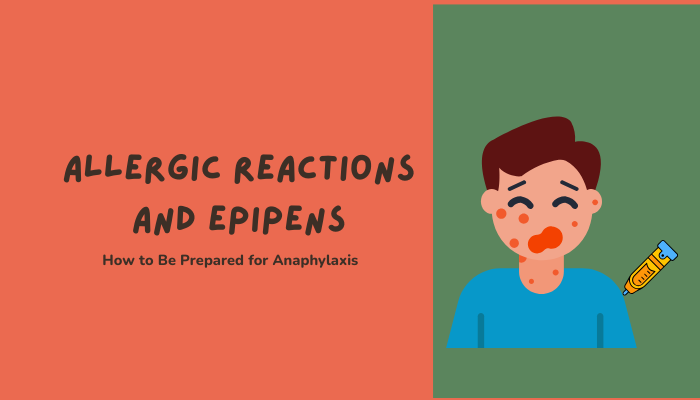Introduction
Allergic reactions vary in severity, but anaphylaxis is the most extreme and life-threatening. It occurs when your immune system releases a flood of chemicals in response to an allergen, leading to airway constriction, severe swelling, and dangerous drops in blood pressure.
In these moments, rapid and correct treatment can determine the outcome. That is where EpiPens and other epinephrine auto-injectors become crucial. This guide explains what anaphylaxis is, how to recognize it, and how to use an EpiPen properly.
What Is Anaphylaxis?
Anaphylaxis is a systemic, severe allergic reaction that can escalate within minutes. Characterized by:
- Widespread Vasodilation: Causes blood pressure to drop, risking shock.
- Airway Constriction: Swelling in the throat or tongue obstructs breathing.
- Rapid Onset: Symptoms can intensify quickly, sometimes in seconds.
Without immediate intervention—typically with epinephrine—anaphylaxis can be fatal. However, prompt use of an EpiPen or epinephrine auto-injector often reverses these effects, restoring breathing and stabilizing circulation.
Common Triggers of Severe Allergic Reactions
Any allergen can trigger anaphylaxis, but some of the most common include:
- Foods
- Peanuts, tree nuts, shellfish, eggs, milk, wheat, soy.
- Peanuts, tree nuts, shellfish, eggs, milk, wheat, soy.
- Insect Stings
- Bees, wasps, hornets, yellow jackets, fire ants.
- Bees, wasps, hornets, yellow jackets, fire ants.
- Medications
- Penicillin and other beta-lactam antibiotics, NSAIDs, or certain chemotherapy drugs.
- Penicillin and other beta-lactam antibiotics, NSAIDs, or certain chemotherapy drugs.
- Latex
- Gloves, medical equipment, balloons, or rubber-based products.
- Gloves, medical equipment, balloons, or rubber-based products.
Those with known severe allergies often carry an EpiPen in case of accidental exposure.
Recognizing Signs of Anaphylaxis
Symptoms can vary person to person but often include:
- Respiratory Issues: Wheezing, difficulty breathing, chest tightness.
- Swelling: Of the lips, tongue, throat, or face, leading to potential airway blockage.
- Skin Reactions: Hives, flushing, intense itching.
- Cardiovascular Problems: Dizziness, fainting, rapid or weak pulse.
- Gastrointestinal Issues: Nausea, vomiting, diarrhea, abdominal cramping.
Anaphylaxis should be assumed if multiple systems (e.g., skin + respiratory + GI) are involved shortly after allergen exposure.
EpiPens: The Basics
An EpiPen (or similar epinephrine auto-injector) is a portable device injecting epinephrine (adrenaline) into muscle tissue. This:
- Opens the Airway: Relaxes smooth muscles in the airways, alleviating wheezing and breathing difficulty.
- Constricts Blood Vessels: Raises blood pressure to counteract severe drops.
- Reduces Swelling: Helps relieve edema in the throat, mouth, and other tissues.
EpiPens require a prescription, and many individuals with known severe allergies keep multiple units on hand: at home, work, or school, as well as in personal bags or vehicles.
Step-by-Step: How to Use an EpiPen
- Remove from Carrier
- Take off the safety cap (often blue or orange) to expose the injection end.
- Take off the safety cap (often blue or orange) to expose the injection end.
- Firm Grip
- Hold the auto-injector in your fist, with the tip pointed downward.
- Hold the auto-injector in your fist, with the tip pointed downward.
- Inject into Outer Thigh
- Press the tip firmly against the mid-outer thigh (through clothing if necessary).
- Listen or feel for a click.
- Press the tip firmly against the mid-outer thigh (through clothing if necessary).
- Hold for Several Seconds
- Typically 3 to 10 seconds as per device instructions.
- Remove it from the thigh; the needle automatically retracts in many models.
- Typically 3 to 10 seconds as per device instructions.
- Massage the Injection Site
- Rubbing the area for about 10 seconds may help absorption.
- Lay the person down unless breathing is easier in a sitting position.
- Rubbing the area for about 10 seconds may help absorption.
Immediately after using an EpiPen, call emergency services if you have not already. Some patients need additional doses if symptoms return.
What to Do After Using an EpiPen
- Seek Medical Evaluation: Anaphylaxis can reoccur or intensify, so professional assessment is critical.
- Monitor for Biphasic Reaction: Some individuals experience a second wave of symptoms hours later.
- Inform Medical Staff: Let paramedics or ER teams know your allergen, time of injection, and any other relevant medical history.
Other Preparedness Tips
- Wear Medical ID: A bracelet or necklace indicating severe allergies helps first responders act quickly.
- Regular Training: Practice using a trainer EpiPen or watch demonstration videos to stay comfortable with the device.
- Storage: Keep auto-injectors in a cool, dry spot—avoid extreme heat or cold. Always check expiration dates.
- Notify Others: Family, friends, or coworkers should be aware you carry an EpiPen and how to help if you cannot self-inject.
Long-Term Management and Follow-Up
Individuals prone to anaphylaxis often work with allergists or immunologists to:
- Identify Allergens: Skin or blood tests isolate triggers.
- Consider Desensitization Therapy: Gradual allergen exposure can lessen sensitivity for certain triggers (e.g., peanuts, venom).
- Develop an Action Plan: Document step-by-step instructions on what to do if an attack happens.
Conclusion
Severe allergic reactions can escalate in minutes, but an EpiPen injection significantly improves outcomes when used promptly. Recognizing anaphylaxis signs—like breathing difficulties and rapid swelling—and administering epinephrine are first-line life-saving measures.
Keep your auto-injector accessible, replace it as needed, and educate those around you. With the right preparation, you can face potential anaphylaxis confidently and minimize danger.
References
- American Academy of Allergy, Asthma & Immunology (AAAAI). (2020). Anaphylaxis guidelines.
- World Allergy Organization (WAO). (2021). EpiPen usage and storage recommendations.
- National Institute of Allergy and Infectious Diseases. (2019). Managing severe food allergies.
- American Red Cross. (2020). First aid steps for anaphylaxis and EpiPen instructions.
Disclaimer: This content is for educational purposes and does not replace professional medical guidance. If you suspect anaphylaxis, administer epinephrine and seek immediate emergency care.

